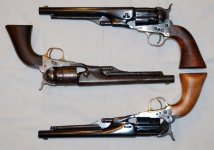Pohill, I realize now you were just joking. Lol. But I was wondering which way you meant that when I thought you were being serious. According to what you wrote, it could be taken two ways.
1. You meant that once fired, as you re-cocked the revolver, the caps smoothly fell off the nipples and smoothly rolled out the built in cap ejection channel in the receiver. (Which of course is what they are supposed to do and what that cap channel is for, if the caps do in fact come loose from the nipples after firing).
2. You meant that upon firing, the caps blew straight back off the nipples.
The first one is normal and frequent even though often the fired caps stay on the nipples and don't eject out the built in cap channel in the receiver.
But the second one isn't actually that outlandish either, since if your nipples were drilled out to the correct aperture, and you used the same powder load all the time, it is very possible that you could have meant that the caps smoothly blew off the nipples, thus "ejecting like a semi-auto".
I have frequently thought about that possibility. We all know how the ejector on a semi-auto works. The spent shell comes back and encounters the ejector coming through a groove in the bolt, and the ejector hits against the left side of the spent case, causing the spent case to eject out to the right.
If one were to drill out their nipples to enable more gas pressure to impinge rearwardly upon the caps upon firing, thus being enough gas pressure to blow the caps off the nipples, and then modify their 1860's hammer so that it wasn't flat all across where it contacts the cap, but instead had an angle to the right side of the hammer's face, it could be possible that not only would the caps blow off the nipples due to gas pressure, but also that if the nipples were drilled out enough, that the very small and short rearward movement of the cap off the nipple, would also move the hammer back just enough to where it doesn't actually cock the hammer (so it doesn't go full auto), but to where it just barely moves the hammer enough rearwardly to where the face of the hammer is off the cap and allows the cap to fly out, hit the angled face of the hammer and fall into the cap channel of the receiver frame, all without actually causing the cylinder to advance, since the hammer doesn't move rearward enough for the cylinder pawl to move upward enough to engage or advance the cylinder.
And due to an angle set on the right face of the hammer, that the caps would blow off the nipples and encounter the angle on the hammer face and then eject to the right side into the cap channel of the receiver frame, instead of blowing back and hitting the face of the hammer and just falling directly downward into the hole of the hammer thus jamming the action. The trick would be to get the hammer to just come back far enough for the caps to just barely blow off the nipples, hit the angled face of the hammer and be deflected to the right, into the cap channel of the frame and fall out the revolver, all without the hammer coming back far enough to cause any cylinder advancement, so it wouldn't go full auto.
It would take some experimentation with different size caps, different nipple apertures and powder loads and milling an angle into the face of the hammer that doesn't also prevent the hammer from popping the cap, (although it would mean that the hammer would only hit against the rear middle and left of the cap's rear, (the right side of the hammer's face not contacting the cap to fire it, since it is angled so that the cap can be deflected to the right by it).
Not that crazy really. I think it could be done.
And I agree Pohill, that WOULD be a great feature.
.


